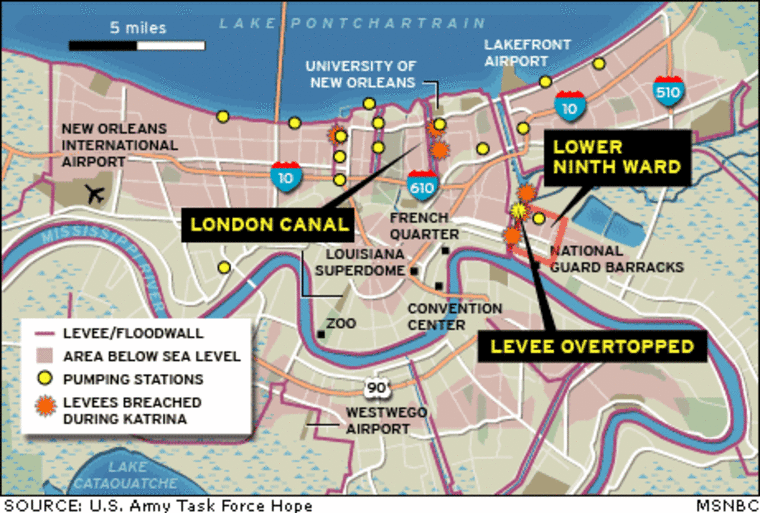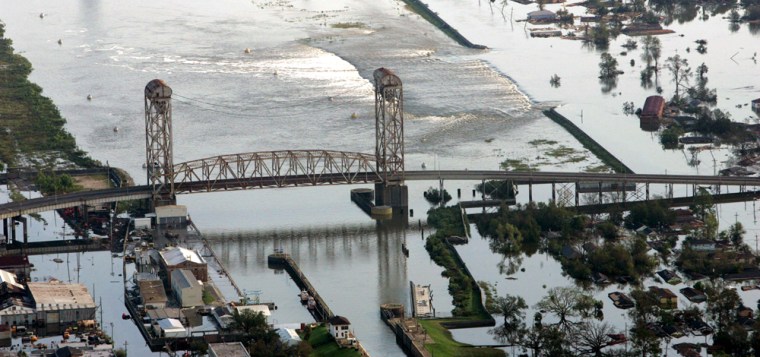As failing levees allowed the murky waters of Lake Pontchartrain to inundate the streets of New Orleans on Tuesday, one thing was becoming clearer: Staunching the flood tide was not likely to be a quick fix.
Confusion persisted for much of the day over where the levees in the below-sea-level city had been breached and how badly. But as evening fell, the most serious problem continued to be “a large section of the vital 17th Street Canal levee, where it connects to the brand new ‘hurricane proof’ Old Hammond Highway bridge,” according to the Web site of the New Orleans Times-Picayune. Smaller breaches were reported elsewhere.
The main gap, caused by Hurricane Katrina’s storm surge and hundreds of feet wide, allowed millions of gallons of water from Lake Pontchartrain to flood scores of neighborhoods across the city. The water was high enough in the downtown district by 5 p.m. that Louisiana Gov. Kathleen Blanco said the tens of thousands of people huddled in the Superdome and other rescue centers would have to be evacuated.
While some officials had earlier expressed hope that the levee might be plugged in a matter of hours, nobody was saying that by Tuesday afternoon.
“That breach is not going to be fixed today, tomorrow or the next day,” Mark Smith of the New Orleans homeland security office told the Shreveport (La.) Times.
'A very bad situation'
“It’s a very bad situation,” agreed Jim Baker, operations superintendent for the East Jefferson Levee District, whose own levees were holding.
At 5 p.m. ET, a harried Baker told MSNBC.com via telephone that his district was sending help in the form of 3,000-pound sandbags to the New Orleans district. Each bag holds a cubic yard of sand.
“You dump anything you can dump into it,” Baker said. Helicopters would be used. “Right now, that’s the only way to get them over there to that site.” Stressing that he is not an official spokesman for the district, Baker would not venture an estimate on how long it might take to plug the leak.
Nor would Harry Stewart, a levee-repair expert from California. “I don’t know enough about that levee system to comment specifically,” said Stewart, who works for the Dutra Group, the leading fix-it firm on the hundreds of miles of levees in the Golden State’s Sacramento-San Joaquin Delta.
But Stewart allowed that the problem sounded like one that would take more like days or weeks to repair than hours. “A lot of it goes to how quickly (the levee) can be raised,” he explained. And that depends on the two local conditions of access to the breach and the availability of material to fill it.
With access and material, “Within a week or two, you ought to be able to get that repaired,” Stewart told MSNBC.

A levee break several hundred feet long in California’s Jones Tract took more than a month to repair last summer, according to Don Strickland of the state’s Department of Water Resources.
Lt. Gen. Robert Flowers, retired chief of the U.S. Army Corps of Engineers, said New Orleans has a "very extensive" system with two types of levees: One set holds the water back from the Mississippi River; the others provide protection from Lake Pontchartrain when it swells during hurricanes and other storms.
Flowers said that he noticed in his time with the Corps that development and loss of wetlands along Louisiana's coast had cost New Orleans a lot of "natural hurricane protection."
Filling the breach is just the first part of the fix. Getting rid of the floodwater is the second.
“New Orleans isn’t going to drain,” science writer Eric Berger of the Houston Chronicle told MSNBC, so the water will have to be pumped out.
And while "some pumping can be done while those levees are being repaired," Flowers said, "this is a tough one. They're in for a long, hard pull in recovering from Katrina."
In the California case, it took five months to pump all the water out of a 12,000-acre area that had been covered to an average depth of 12 feet.
